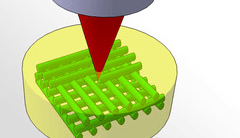Photografting: 3D Printing with Molecules
on

Researchers at TU Vienna have developed a special ‘photografting’ technique that allows molecules to be positioned in a 3D substrate to produce more versatile and accurate sensors for 'lab on a chip' devices. The researchers had previously explored new kinds of 3D printers, but 3D printing is not suitable for the envisaged applications because putting together materials from tiny components with different chemical properties is very complicated. Instead, they took the approach of starting with a three dimensional scaffold and attaching the desired molecules at exactly the right positions.
The process begins with a hydrogel with large pores through which molecules or even cells can migrate. Specifically selected molecules are introduced into the hydrogel mesh, and then certain points are blasted with a laser beam. This causes photochemical bonds to be broken where the focused laser beam is most intense, creating highly reactive intermediates that bond to the hydrogel in their vicinity very quickly. The precision depends on the laser’s lens system; the researchers were able to obtain a resolution of 4 µm.
Various molecules can be used, depending on the application. 3D photografting is useful not only for bio-engineering, but also for other fields, such as photovoltaics or sensor technology. It allows precise positioning, in very small spaces, of molecules that bond to specific chemical substances and allow them to be detected in a ‘lab on a chip’.


Discussion (0 comments)